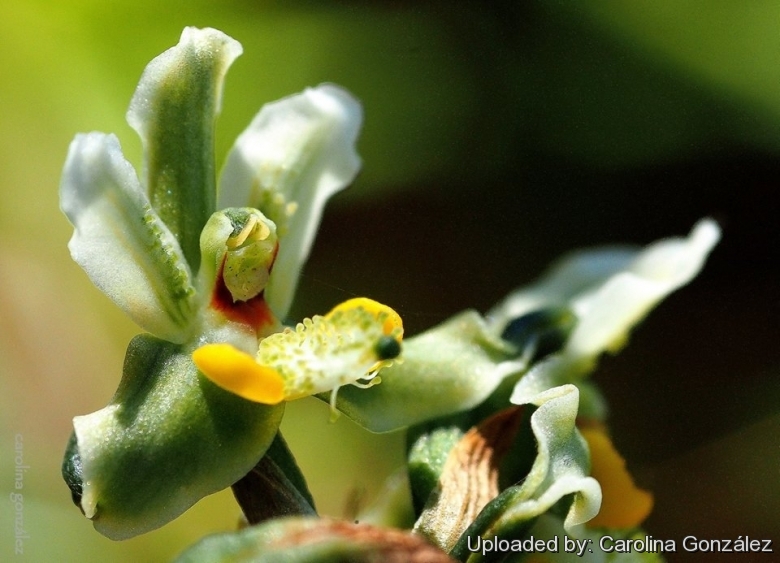Accepted Scientific Name: Gavilea araucana (Phil.) M.N.Correa
Bol. Soc. Argent. Bot. 6: 82 (1956).

Gavilea araucana at San Martín de los Andes.
Origin and Habitat: This species is found in southern Chile and Argentina from Neuquén to Santa Cruz (between parallels 39º and 51º of south latitude).
Habita and ecology: Gavilea araucanaSN|35564]]SN|35564]] grows on hills or slopes in clear forest sites, usually on the banks of Great Lakes. This orchid has also been found in small populations in sites affected by forest fires. It flowers in summer (December), and fruits ripens in December and January. This population of five G. araucana individuals with flowers, located in a Park, represents the first record for Chile. The orchids are growing from the Sphagnum carpet (lawns and humock)
Synonyms:
See all synonyms of Gavilea araucana
back
Accepted name in llifle Database:Gavilea araucana (Phil.) M.N.CorreaBol. Soc. Argent. Bot. 6: 82 (1956).Synonymy: 3
back
Description: Gavilea araucanaSN|35564]]SN|35564]] is a terrestrial, upright, orchid, up to 50-70 cm tall. The flower has creamy white, ovate-lanceolate sepals with long green tips, and the petals have green dashed lines or spots. The lip is cupped with a red, narrow claw and three lobes, the middle lobe irregularly green-striped, the two lateral erect lobes yellow.
Derivation of specific name: Gavilea araucanaSN|35564]]SN|35564]] is named for the region in Chile called Araucania, a former independent kingdom ruled by the Mapuche people. It was here that first encountered the species.
Leaves: 3 or 4 arranged in rosette, linear-lanceolate, acute, 15-25 cm long by 2-4 cm wide, with 5 longitudinal ribs.
Inflorescence: 8-15 flowers are loosely arranged on an erect unbranched stalk and open from the lowest or inner branches to the top. Bracts lanceolate, acute, slightly surpassing the ovary.
Flowers. Ivory or pale yellow with green streaks with oval-lanceolate, sharp bracts that barely surpass the ovary. Dorsal sepal about 18 mm long, 5 mm wide, oval-lanceolate, sharp. Lateral sepals up to 27 mm long, 6 mm wide, oval-lanceo-late, with thin caudicule up to 12 mm long. Petals with varicose veins, at base. Labellum 3-lobed, lateral lobes forming an obtuse angle with the central lob, notorious rounded veins, apical margin slightly sinuose, central lob elongated, more or less triangular, with veins cross over by few flakes with thicken margins, margin laciniate or merlon-shaped. Column 5 to 6 mm, with 2 folds at the contact place with the labellum.
Fruits (capsules): Globose and cylindrical.
Bibliography: Major references and further lecture
1) Mark W. Chase, Maarten J. M. Christenhusz, Tom Mirenda, “The Book of Orchids: A Life-Size Guide to Six Hundred Species from Around the World”, University of Chicago Press, 13 March 2017
2) "Gavilea araucana." Wikipedia, La enciclopedia libre. 11 may 2017, 17:12 UTC. 24 dic 2018, 16:39 <https://es.wikipedia.org/w/index.php?title=Gavilea_araucana&oldid=99063402>.
3) “Orquídea (Gavilea araucana)” Web: http://www.parquekatalapi.cl/fileadmin/templates/Katalapi_datos/material_educativo/orquidea-gavilea-araucana.pdf
4) Erwin Dominguez & Nelson Bahamonde, “Gavilea araucana (Phil) M.N.Correa: first record of an orchid for Chile on Sphagnum peatland in Magallanes” Biodversity Journal, 4 (1): 125-128, 2013
Cultivation and Propagation: Gavilea araucanaSN|35564]]SN|35564]] is an attractive species from Chile and Argentina but due to its problematic cultural requirements it is not seen in horticulture.








